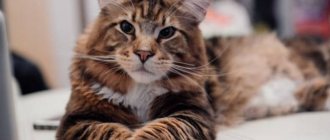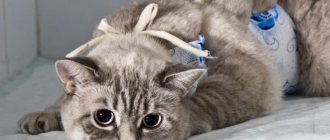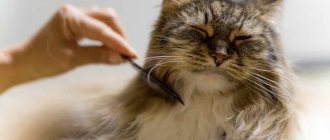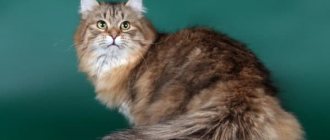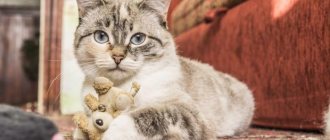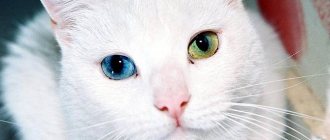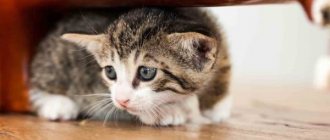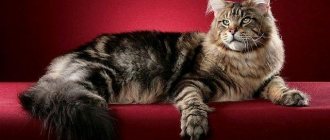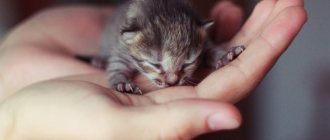Grooming
The Siberian cat requires attention. The first step in caring for a Siberian cat is to take care of its beautiful coat. This way you can not only emphasize your aristocratic appearance, but also improve your health. This type of grooming includes removing dead skin flakes and hairs. At the same time, blood circulation is stimulated, which significantly improves the condition of the coat and skin. Moreover, regular grooming promotes the development of psychological intimacy between the owner and the cat, creating a special mood.
Wool plays not only a decorative role - thanks to it, the Siberian cat is reliably protected from water, cold and minor injuries. Since the coat consists of a short undercoat and long outer hairs, care for the coat, including the skin, is divided into preparation for shows, daily care and washing.
Regular grooming means that from the very first days a kitten appears in the house, you need to start caring for its fur. They do this by combing it. This way you can quickly accustom your kitten to combs and various brushes, then he will enjoy this procedure, and daily combing will significantly improve the condition of his fur and skin, prevent the formation of tangles and protect against the accumulation of hair in the stomach, which can lead to clogging and even death.
To groom a kitten, you will need several brushes, but it is important not to use artificial bristle brushes - the resulting static electricity makes the fur brittle and causes discomfort for the kitten. You need to comb in the direction of hair growth, and you need to start with a metal comb with rare teeth, it is replaced by a comb with more frequent teeth, ending with a fine-toothed comb. The tail is combed out with a brush, and the undercoat is removed with a slicker brush. This is done infrequently and only during molting. With a slicker you can beat the fur well, and then the cat becomes even fluffier and more beautiful. This can be done while preparing it for an exhibition.
What do Siberian cats get sick with?
These cats have truly “Siberian” health. The only disease that can affect these purrs is hypertrophic cardiomyopathy, typical for cats. The disease is hereditary, and is dangerous because in many cases its first sign is the sudden death of the cat. But, fortunately, this disease is very rare.
Remember the need for vaccinations and preventive examinations with a veterinarian. These preventive measures will keep your Siberian cat healthy for many years to come.
Specifics of kitten care
You need to take care of your kitten with all diligence, because this is what determines what kind of cat it will grow up to be. For example, teach your baby to comb his hair. If you accustom him to a comb every day for 5 minutes, then caring for his fur will be a complete pleasure, both for you and for him.
Another important milestone in a baby’s education is to teach him to go to “his” toilet; a Siberian cat usually has no problems with this. It is only important to make sure that it stands in a secluded place and there is always fresh cat litter there.
It is better to prevent the appearance of fleas by dropping medications on the base of the tail and withers. Then for the summer you will forget about fleas and ticks. In this regard, collars are less reliable than good drops.
After 3 months it is important to get vaccinations. It is better to go to a state veterinary clinic, just get rid of the worms a couple of weeks before.
Colors
This breed comes in a wide variety of shades. Chocolate, Burmes and cinnamon colors are considered undesirable. White color and colorpoint is a separate subspecies - Neva Masquerade. Let’s see what the Siberian cat breed looks like in different shades in the photo.
Tortoiseshell or tabby cake
This color is presented in the form of mosaic spots, the main shades of which are cream and red. The spots should be scattered chaotically and not create patterns.
Tabby
This wild shade is presented in the form of light brown or gray stripes or spots. Thanks to this color, cats are able to camouflage well while hunting.
Smoky and silver or smokey silver
The Siberian blue cat with a silvery tint has its own special charm. Smooth transitions of gray shades should not create patterns on the body.
Gold
This noble color is presented in the form of a warm apricot shade. Golden cats usually have clear green eyes.
White
White Siberian cats are often compared to the Turkish Angora, because even their eye color can range from green to sky blue.
Bicolor
This is a combination of two shades. It can be plain with white or tortoiseshell with interesting white inserts.
Colorpoint
Point cats are presented in delicate colors with spots of various shades.
Tabby points
This shade includes dark brown, cream and tortoiseshell points.
Miscellaneous
Siberian cats allowed to roam outside are prone to minor injuries to their paw pads caused by exposure to sharp objects or hypothermia. Baby cream will help you - after cleaning the paw pads from dirt, gently rub it into the skin.
Caring for the teeth of a Siberian cat will also require special attention. Since regular tooth brushing is difficult to achieve, prevention is important. By choosing food and monitoring its variety, you can avoid tartar and gum inflammation. A Siberian cat must receive a variety of food, including vegetables, cereals and even fruits.
Normally, a Siberian cat does not need to have its nails filed or trimmed. The exception is cases when she was forced to be immobile for a long time, cannot take care of herself due to old age, etc.
Character
The Siberian cat has a calm and friendly character, which makes the cat a good companion. Representatives of this breed are very sociable and become strongly attached to their owner. This feature has its pros and cons:
- If you are unable to provide your cat with the attention it deserves, your pet will be bored.
- On the other hand, a cat can become your most faithful friend who will accompany you for the rest of its life.
Siberians are often compared to a dog: the cat is distrustful of strangers, can defend its territory, and is wary of loud extraneous sounds.
The Siberian cat perceives other animals in the apartment as competition. He shows calmness and patience towards children, loves to play pranks and play with them.
The breed is distinguished by a sharp mind; they are smart enough to quickly perceive new information. Thanks to this, cats easily learn the rules of a new home.
Nutritional Features
Unfortunately, the domestic Siberian cat is deprived of natural sources of nutrition and is completely dependent on the owner for this. She should be fed only in the designated area, and the food bowl should be stable and not too deep. After finishing the meal, you need to remove any leftover food and wash the bowls, otherwise your cat may get an upset stomach or poisoning.
Feeding a cat requires special attention. If her diet is a matter of her whim or consists of only leftovers, it will end in metabolic disorders. Feeding correctly means choosing a diet in which nutrition will contribute to the formation of the skeleton, normal metabolism, hair growth and will become a source of strength and vigor. What to feed a Siberian cat and what size of portions are determined by the age, condition of the animal and whether you have a cat or a she-cat.
Feeding Siberian cats is based on the following rules:
- the portion is the correct size if your cat is moderately well-fed and does not look skinny or overfed;
- you need to feed with enough variety, and most importantly with properly balanced foods;
- An adult cat prefers to eat what he ate when he was a kitten. If the kitten's feeding was limited to just one food, it will be very picky;
- treats that your cat receives in addition to main meals make up no more than 10% of the daily diet;
- you should always feed at the same time, always in the same place, always from clean bowls and always with food at room temperature;
- It is recommended to feed an adult twice a day;
- The Siberian cat's diet must contain sufficient amounts of vitamins and nutrients;
- up to 3 years old, a Siberian cat should be fed so that the diet contains about 70% of the protein necessary for the formation of the body;
- prolonged and monotonous feeding of canned food and dry food causes the development of diseases of the pancreas, liver, etc.), just as you cannot feed only meat, then the liver receives an unwanted load;
- To prevent your stomach from becoming clogged with wool, be sure to give low-fat kefir or cottage cheese, besides, they are rich in calcium;
- from childhood, the cat needs to be fed vegetables and cereals;
- The cat should always have fresh water or (if she is reluctant to drink water) liquid food. Otherwise, it will be difficult to avoid dehydration and metabolic disorders;
- It is important to feed your cat grass (or greens). Not only is it a source of fiber, folic acid and vitamins, but it also removes hairballs that accumulate as a result of licking the fur.
Bathing
Before washing, comb the animal well.
Place a towel or rubber mat in a small basin. This prevents your pet's paws from slipping while bathing. The water temperature is approximately 38-39 degrees Celsius, the level is approximately 8-10 cm. The animal is placed in a basin, there is no need to immediately pour water on it, first the wool is soaked with water, using a sponge and not touching the head area. If the cat becomes very nervous during this first wash, do not make sudden movements or turn on the water or shower too much. Close the bathroom door to prevent the animal from escaping.
The washing itself is done with shampoo, which is different for each cat (the choice is individual and depends on the breed and color). To rinse off the shampoo, use warm water and a mug or ladle (shower heads can frighten the cat). After bathing, the pet should be wrapped in a warm, dry cloth (towel) and dried. It is better not to dry the animal with a hairdryer, because the noise of the device can frighten it, which will lead to nervous shock to the cat and it can injure and scratch the owner. It is better to calm the animal during the procedure, pet it and talk to it. The procedure should be performed by the owner whom the cat trusts most. A cat can dry itself after bathing only in a warm place; drafts must be excluded, otherwise it will catch a cold. Keep an eye on this. You need to wash your cat as it gets dirty, it depends on whether it walks outside; frequent washing is contraindicated. If your pet is only at home, you can carry out water procedures 2-3 times a year.
The Siberian cat will become an excellent friend to your family, however, its fur requires some care, and when getting such a pet you must be prepared for this.
Name ideas for this breed
Choosing a name is a crucial moment for the owner of the animal. The nickname may reflect the character and appearance of the pet. But the main thing is that the cat must respond to its name.
Siberians are often called names that are pleasant to the Russian ear - Styopa, Musya, Mityai, Umka or Barsik. Since Siberian kittens look like fluffy balls, homely, cozy nicknames suit them perfectly.
You can also involve the kitten in the selection process. Call him by different names and settle on the one to which the animal reacts.
Health and life expectancy
All cats can suffer from certain diseases. Kidney disease, cancer, urinary crystals and gum disease are common in many breeds.
Siberian cats are generally healthy and hardy animals. Research shows that they are one of the few cat breeds with the greatest genetic diversity in their population. This makes them less prone to problems from inbreeding. Basically, this breed, due to its natural origin, has good health. As with other cats, the main ailments of the Siberian breed are a tendency to urolithiasis and clogging of the stomach with hair. But heart problems are also common in this breed.
Heart disease is most often inherited and is the leading cause of death in domestic cats. This causes the heart wall to thicken and heart failure occurs. This disease can occur in a Siberian cat at any age. Today, genetic research is being conducted into the causes of this disease. Therefore, when buying a kitten of this breed, you should make sure that there are no representatives with a similar disease in its pedigree.
A cat's lifespan is based on a number of factors, including diet, lifestyle, environment and genetics. Since Siberian cats are strong and have minimal health problems, they are one of the longest-living breeds. Most often, the life expectancy of these animals is from 11 to 15 years.
A little history
According to one version, Siberian individuals have Asian roots. The first mention of these animals can be found in publications from the times of the Bukhara state (1756–1920), located in Central Asia.
At that time, Siberian cats were called Bukhara cats. There is no exact information about when and how they got to Siberia. It is believed that they were brought by Central Asian merchants during a period of active trade between the countries.
The breed was formed in harsh climatic conditions, which contributed to the appearance of thick fluffy fur in cats - the calling card of Siberians.
The first official registration took place in 1987. The standard was approved in 1992.
Appearance
The Siberian cat is a fairly large breed, weighing up to 15 kg. Siberian cats are much heavier than females. Animals have long, waterproof fur, which is especially noticeable in the winter. A distinctive feature of the breed is a peculiar ruff on the neck, a fluffy head and tail. Their body is barrel-shaped. The cat's head is shaped like a rounded wedge.
Sometimes this breed may have hair on the tops of their ears which makes the rounded ears appear more pointed. This detail gives a visual resemblance to wild representatives of this cat.
Siberian cats have hind legs that are slightly longer than their front legs. Overall the animal looks very balanced and graceful. Siberian cats are also very active and acrobatic.
